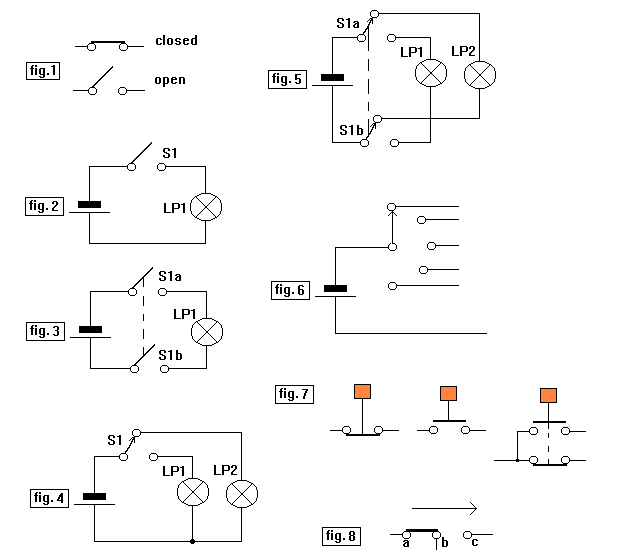Fig.
1
Switches
are used to open/close a circuit.
Fig.
2
S1
is a "single pole on/off" switch in the off position.
Fig.
3
This
is a "2 pole on/off" switch which completely isolates the lamp from the
supply in the off position.
This
may be important if it is a high voltage supply.
The
dotted line indicates that S1a and S1b are part of the same switch "ganged"
together and operate simultaneously.
Fig.
4
This
is a "single pole changeover" switch.
Either
lamp 1 or lamp 2 is on.
Fig.
5
This
is a "2 pole changeover" switch.
The
unlit lamp is completely isolated from the supply.
Again
S1a and S1b are part of the same switch.
Fig.
6
This
is a "single pole 5 way" switch.
It
can select 1 of 5 circuits.
You
can have 2p 5w, 3p 4w etc.
Fig.
7
This
shows
(1)
a "normally closed, push to break".
(2)
a "normally open, push to make".
(3)
both used together to make a "changeover" switch.
Fig.
8
This
is a "changeover" slide switch.
When
operated a-b opens and b-c closes.
Here
are assorted switch types. Panel-Toggle-Make before break-Pneumatic-Wafer-Proximity-Light
activated-Toggle-Rotary Reed-Pull-Locking-Vane-Interlocking-Rocker-Dimmer-Mercury-Tilt-Microswitch
Thumbwheel-Key-Wafer-Slide-Float-Optical-Foot-Thermal-Hall effect |

